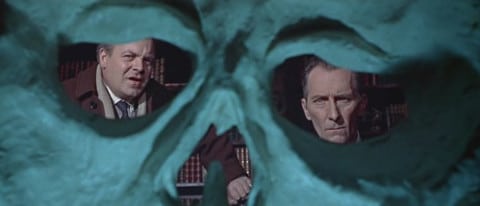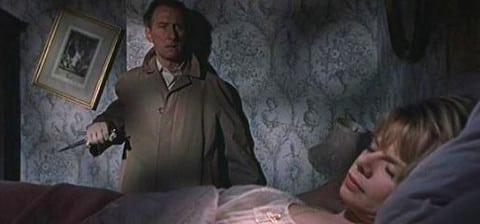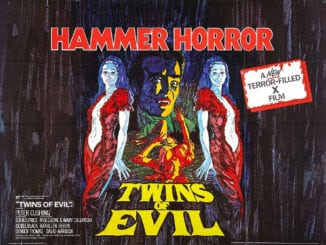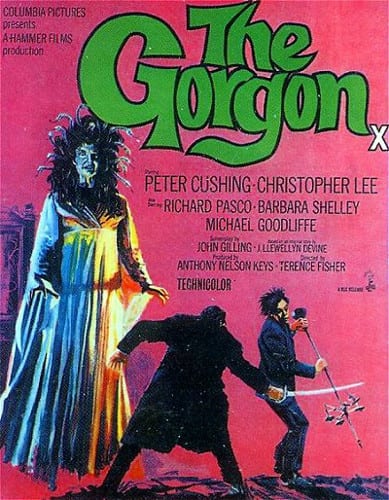The Skull (1965)
Directed by: Freddie Francis
Written by: Milton Subotsky, Robert Bloch
Starring: Christopher Lee, Jill Bennett, Patrick Wymark, Peter Cushing
UK
AVAILABLE ON DUAL FORMAT BLU-RAY AND DVD: 26TH OCTOBER, from EUREKA ENTERTAINMENT
RUNNING TIME: 83 min
REVIEWED BY: Dr Lenera, Official HCF Critic
In the 1800s, Pierre breaks into the grave of the recently buried Marquis de Sade. He cuts off the head and sets about boiling it to remove its flesh, leaving only the skull. Before he’s finished, Pierre meets an unseen and horrific death. In the present day, Christopher Maitland, a collector and writer on the occult, bids on some occult statues only to see the auctioneer award them to Sir Matthew Phillips, who readily admits that he doesn’t know why he felt compelled to buy. Maitland, who is relying a great deal on disreputable dealer Anthony Marco to bring him rare items, buys from him La Vie du Marquis De Sade, a book containing the writings of the notorious author and sadist the Marquis De Sade. Then Marco offers Maitland a truly fantastic find – the skull of the Marquis himself, but Maitland is unsure of its authencicity, while Sir Matthew warns him not to accept delivery because the skull will bring disaster to whoever possesses it….
The Skull has something of a reputation as one of the most interesting British horror films of the 1960’s, and had almost attained something approaching mythical status in my mind. If you read a lot about films as well as watch loads of them, there are always certain films which take you ages to get to see, and often you end up being let down when you finally do so because the version of the movie you’d created in your head was different or better than the version of the movie that you actually ended up watching. Despite being a big fan of horror old and new, and in many respects preferring the old, I’d never got around to seeing The Skull, though it’s never been that hard to obtain even though I don’t remember it ever having been shown on TV, even back in the day when the films of Hammer, Amicus, Tigon and other studios would constantly be shown, usually on a Friday night. For pretty much the first half of The Skull, I found the film to be decent, old-school horror entertainment notably mainly for some creative camerawork, but then the film began to get stronger and stronger and really took off in its final third in a far more experimental fashion than Hammer ever attempted [I love Hammer, as you can no doubt tell if you’ve been reading my Hammer review series, but I do often wish they’d tried a few more different things in their horror films] and ended up actually being quite frightening. And it also contains one of Peter Cushing’s finest ever performances.
Amicus Productions were perhaps Hammer’s strongest rivals in the horror genre in the second half of the 1960’s to the first half of the 1970’s, though being perhaps best known for their anthology pictures beginning with Dr. Terror’s House Of Horrors. The Skull was based on a 1954 short story of the same title called The Skull Of The Marquis De Sade by Psycho’s Robert Bloch. Co-producer Milton Subotsky’s script, which he wrote in three days, added the prologue, though he had to shelve a planned dream scene involving Maitland dreaming he’s being whipped and trapped in an iron maiden after the BBFC objected to it, along with a few other details like the dissolving of De Sade’s head at the beginning and the climax which had to be slightly reworked. God our censors were finnicky back then. Director Freddie Francis thought that Subotsky’s script would have only led to a 50 min film, so he added those lengthy camera pans that now make the film so atmospheric and stretched out the finale as far as he could, though Subotsky once claimed that he pretty much saved the movie in the editing room. Subotsky, though, has been known to stretch the truth. Then the heirs of Donatien Alphonse François de Sade pressed charges to prevent any use of his name on the advertising material and caused the French version to be renamed from Les forfaits du Marquis de Sade [The Infamies Of Marquis de Sade] to Le Crâne Maléfique [The Evil Skull]. The film was only a moderate commercial success.
The Skull actually begins in a somewhat misleading fashion, immediately going into wonderful Gothic mode with a night-time grave robbing scene [very similar, actually, to the one at the start of Frankenstein], replete with windblown cemetery [yeah, it looks exactly like a set, but who cares?], creaky metal gate, owl hoots and a howling dog. There’s even a shot of an owl which I knew I recognised, and found out that it was also used in Hammer’s Dracula for another scene set in a graveyard. The desecrated grave in question turns out to be that of the infamous Marquis De Sade, the reason for the illicit exhumation being the retrieval of his skull, though at the moment we don’t why Pierre wants to boil the skin of it. Lots of smoke under a shut door and his wife screaming at something informs us that something terrible has happened to Pierre, and then we switch to the present day and slowly learn that the same skull is still around and constantly either being passed from person to person or being stolen, and with the end results being murder and madness. We eventually find out that the skull is apparently host to an ancient demon called Baalberith, who drives men to commit terrible acts. It even seems to frighten Christopher Lee, who atypically plays a terrified, nervous man for the rather small amount of time he’s onscreen, [he’s credited as ‘Special Guest Star’], though he does share three scenes with Peter Cushing, one rather amusing as the two play snooker, randomly hitting balls to no avail despite Lee’s character actually owning the snooker room and somehow racking up some points on the score board!
There’s a fairly effective early-ish scene where somebody is driven to kills his wife, and soon after that a rather unnerving dream scene [inserted to obviously pad out the story as in those Roger Corman’s Edgar Allen Poe pictures, but working well within the context of the tale nonetheless] that includes a sinister ride in a car patterned very much after the one that Henry Fonda took when he’s first arrested in Alfred Hitchcock’s The Wrong Man – honestly, many of the shots are the same, but if you have to copy then copy from the best] and a weird combination trial/torture session, though one thing notable about this film [though I suppose this is quite typical of Amicus], even compared to most Hammer horrors which would give you at least a couple of brief moments of gruesomeness, is that there’s hardly any blood or onscreen violence, something that may disappoint some viewers, though after a while I didn’t miss it at all! The tension does ratchet up more and more until we’re treated a final third of what is nothing less than cinematic bravura, consisting mostly of Maitland in his house being overcome by the deadly influence of the skull. We don’t even see much that is supernatural, and even the odd bits that we do see could be put down to madness. I could have actually done without shots of the skull floating, not because you can sometimes see the wires but because I feel they’re unnecessary and slightly lessen the impact of all those shots from inside the skull which are extremely creepy in the way they suggest a demonic presence. In any case, the gliding camerawork, powerful music and, of course Cushing’s superb performance all come together to provide a largely dialogue-less half hour or so which really is quite stunning moviemaking even though little actually happens during it!
Cushing is quite simply brilliant in this film, moving convincingly from dismissive non-believer to panic-stricken victim. As I said in my review of The Martian, I love it when an actor or an actress is given the chance to carry a lot of scenes entirely on their own, and The Skull proves that Cushing was certainly capable of doing that. What lets the side down a bit is the script. Not really attempting to explain things in any great deal was quite a wise move – horror is one genre where what is left unexplained is often better because things are often scarier when you can’t explain them – but the script throws up things like other demons and a secret satanic society, probably to pad out what was originally an eight page story much like the dream, then dismisses them. It’s almost as if Subotsky [and maybe Francis] had a larger scale production in mind but then remembered that the film only had a very low budget so they had to quickly cut a lot of stuff out, though I don’t think that this was actually the case. Despite all this, The Skull looks great throughout – Amicus productions rarely looked as good as those from Hammer, but this one has some plush sets from Bill Constable [who does especially great work when he packs Maitland’s room with as many sinister artifacts as the BBFC would allow] and superb cinematography from John Wilcox creating some expert compositions and even some vivid use of colour, including some curtains bathed in green which show the influence of Hammer’s master Jack Asher but working very well here too.
Francis handles the whole thing with considerable panache. He even throws in a small amount of what is now known as ‘shakycam’ in one scene, and if you have to shake the camera about this is how to do it – to convey a sense of panic and not make the moment last too long so the viewer starts to feel sick! Directorially this could be his best work. The great cast also includes Nigel Green and Patrick Macnee as two cops and Peter Woodthorpe on great sleazy form as the dealer who gives Maitland [why do so many Amicus characters have the surname Maitland?]. The Skull has music by Elisabeth Lutyens, an acclaimed avant garde composer who also happened to score some horror movies. Her often shrill and dissonant scoring, here with much use of percussion, is sometimes a bit overbearing for modern ears but still works very well and helps create much of the atmosphere. While I feel that are a few aspects that weren’t entirely thought through, the surprisingly adventurous, surprisingly frightening and consistently intriguing The Skull really holds up and is a minor classic of British horror cinema, actually surpassing many of the Hammer movies that were being made at the time. It wasn’t really what I expected at all, but on this occasion was all the better for it.
Rating: 









Eureka’s Region B Blu-ray, which a small amount of research reveals easily surpasses the Region A release from Legend Films, is a fine presentation of the film, right from the beginning. The restored print looks very pristine and you can make out a huge amount of detail throughout. As on Eureka’s The Man Who Could Cheat Death disc, experts Jonathan Rigby and Kin Newman talk about the film and are worth hearing one after the other because there’s very little overlapping information. I’d love to here these two together on a commentary for a film like this.
SPECIAL FEATURES:
*Exclusively restored 1080p presentation of the film on Blu-ray
*Optional English subtitles for the deaf and hard-of-hearing
*New video interview with film scholar Jonathan Rigby
*New video interview with critic and author Kim Newman
*Reversible sleeve featuring original and new artwork
*Limited Edition Collector’s Booklet








Be the first to comment